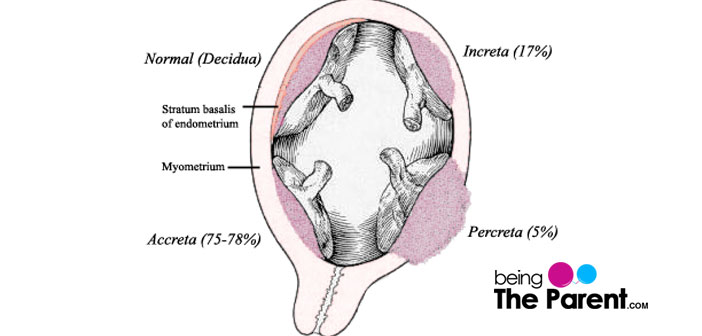The placenta is an astounding organ that plays a significant part in pregnancy in keeping the child alive and well. The umbilical cord of the baby arises from it. It supplies oxygen and nutrients from the mother’s blood to the growing fetus (through the umbilical cord) and eliminates waste products from the child’s blood.

There are several problems related to the placenta, which can make pregnancy and delivery difficult. Some of them can be potentially fatal to the mother, baby or both. One of such serious pregnancy conditions is placenta accreta.
What Is Placenta Accreta?
In a normal pregnancy, the placenta gets attached to the wall of the uterus either at the top or on the side with lots of minute blood vessels. The attachment will be strong enough, but will not penetrate too deep into the uterine wall. The abnormal attachment of the placenta to the uterine wall creates potential issues during pregnancy. Placenta accreta puts a pregnancy under the high-risk category.
Sometimes, the placenta attaches too deep in the uterine wall. Based on the severity and the deepness of penetration this condition is divided into three:
- Placenta accreta: Placenta penetrates deeper than the normal placental attachment but never penetrates the muscle of the uterus. It is the most common (75%) among the three conditions
- Placenta increta: Placenta penetrates deep into the muscle of the uterine wall. Around 15% of the attachment issues of placenta falls under this type
- Placenta percreta: Placenta penetrates through the entire uterus wall and gets attached to other internal organs like the bladder. It is less common among the three conditions(below 10%)
Placental accreta is a critical pregnancy condition (though less severe when compared to the other two types) that happens when blood vessels and parts of the placenta grow too deeply into the uterine wall. Even though the placenta gets strongly attached to myometrium (smooth muscle tissue of the uterus), it will not penetrate the myometrium.
Normally the placenta detaches itself from the uterine wall during the last stage of the labor. But when placental accreta happens, the placenta (partially or entirely) remains firmly attached to the uterine wall too deeply, intertwining its tissue and blood vessels in the uterine wall leading to significant complications.
What Causes Placenta Accreta?
Placenta accreta is usually associated with the abnormalities in the uterine wall which loses its smooth surface. As the surface of the uterine wall becomes uneven and rough due to scarring from previous delivery or as a result of some other issues, the placenta tends to penetrate more to attach strongly.
Who Is At The Risk Of Placenta Accreta?
The chances of having placenta accreta increases if the mother:
- Has already been diagnosed with placenta previa or any other placental abnormalities
- Previous C-section deliveries. Risk increases with the number of deliveries
- Undergone any type of uterine surgery in the past, including C- section. The risk increases with the number of surgeries undergone
- The issues associated with uterus like the presence of sub-mucosal uterine fibroid (non-cancerous growths that protrude into the uterine cavity), scarring in the endometrium (mucus membrane which lines the uterus)
- Having multiple pregnancies
- Increased maternal age (above 35 years) is another factor which influences placenta accreta

How Is Placenta Accreta Diagnosed?
Usually, there will be no indications of placenta accreta visible during pregnancy. If you possess any of the risk factors mentioned above, your specialist will carefully examine the placenta. If not, it will come as an unexpected complication in the course of delivery.
- Placenta accreta can be detected by means of ultrasound or MRI. These imaging tests will help the doctor to evaluate how the placenta is attached to the wall of the uterus
- A blood test is also conducted to find out the presence of elevated amounts of alpha-fetoprotein – AFP (a protein produced by the fetus, which is present in amniotic fluid and the bloodstream of the mother). The doctor will make sure there is no other explanation (like fetal chromosomal abnormalities) for this hike of protein level. The presence of an unexplained elevated level of AFP can be the indication of placenta accreta
What Complications Can Arise Due To Placenta Accreta?
There are various dangers connected with placenta accreta.
- Heavy bleeding: As the placenta will not detach itself, it has to be manually separated from the uterine wall. It increases the risk of severe vaginal bleeding after delivery, more often potentially fatal
- Disseminated intravascular coagulopathy (DIC): This is a potentially life-threatening condition in which the blood starts to clot unusually, making blockage in minute blood vessels throughout the body
- Premature delivery: Placenta accreta can trigger preterm delivery. As there is an elevated chance of heavy bleeding during the last trimester, the doctor may decide to deliver the baby early
- Organ failure: Lung failure and kidney failure are sometimes associated with placenta accreta
How Can Placenta Accreta Be Treated?
Unfortunately, there is not much that can be done for the treatment of placenta accreta. The doctor may:
- Instruct for bed rest for and schedule a delivery
- Once you are diagnosed with placental accreta, your doctor will monitor your pregnancy very closely for the rest of the gestation period for planning a safe delivery and utilizing a surgery that may save the uterus
- In some severe cases, C-section, followed by hysterectomy (removal of the uterus) is performed to save the life of the mother
Can I Avoid Hysterectomy When Severe Placenta Accreta Is Diagnosed?
Rarely, in some circumstances (mainly to conserve uterus) the placenta and uterus are left unimpaired allowing the placenta to melt away as time goes by. Yet, this increases the chance of serious complications like infection, bleeding, developing blood clots blocking one or more arteries thus, increasing the potential risks. Also, women who avoid hysterectomy after a severe placenta accreta possess high-risk pregnancy issues in succeeding pregnancies, including preterm delivery, abortion and the most significant issue of all – recurrence of placenta accreta.
A mothers’ urge to retain the womb for giving birth to more kids is natural. Just remind yourself that reducing the possible complications regarding your health is more important and above all, your little bundle of joy needs you in a good shape.
